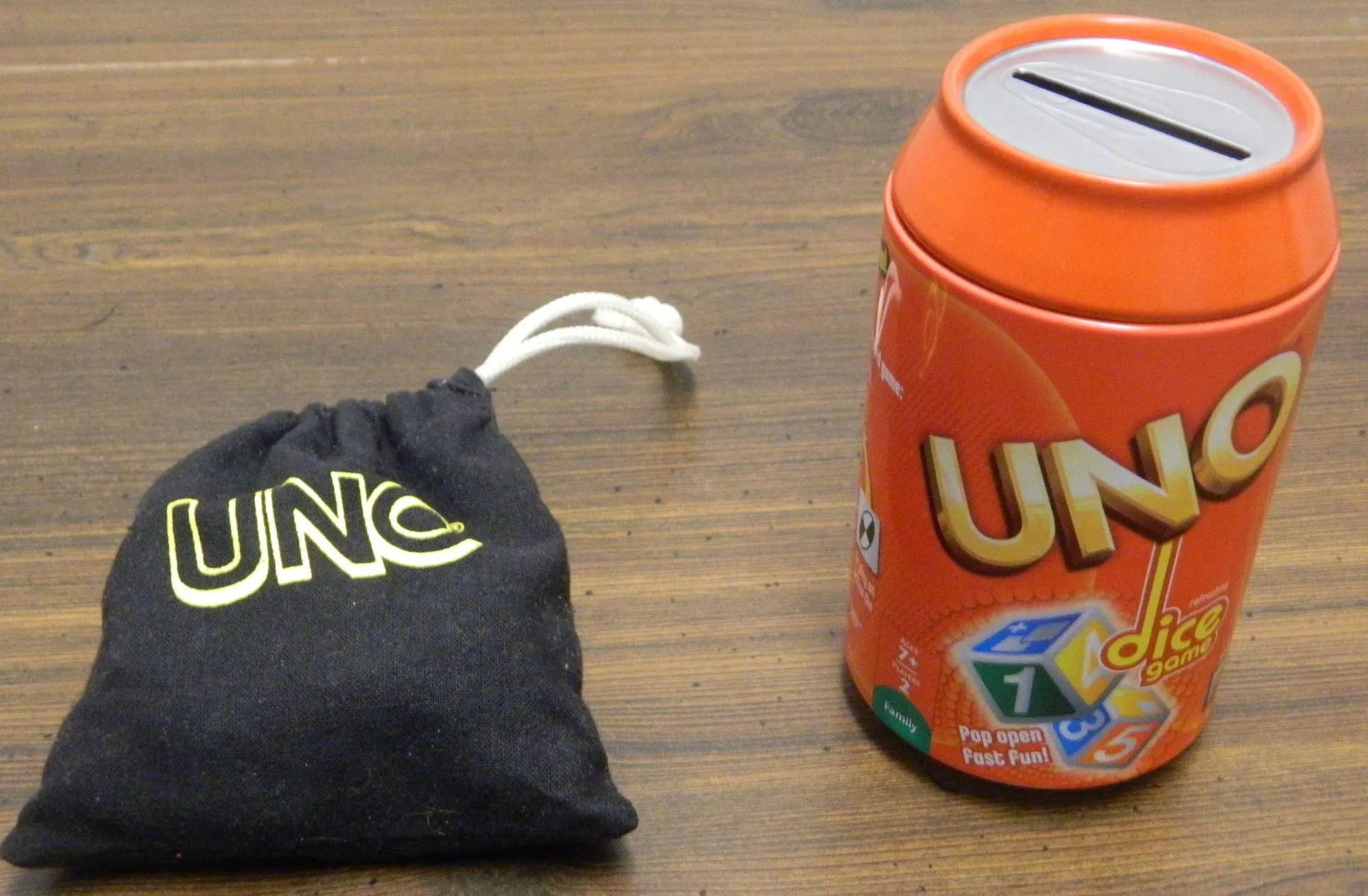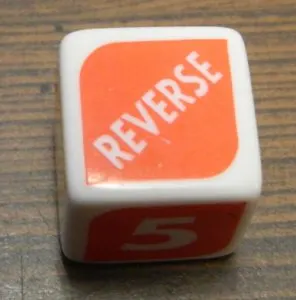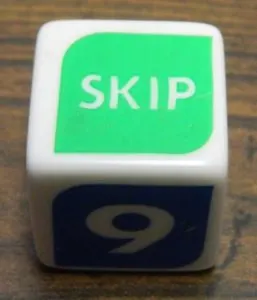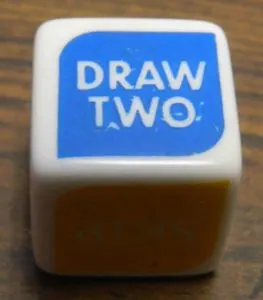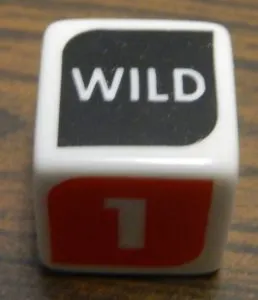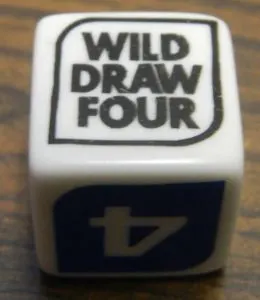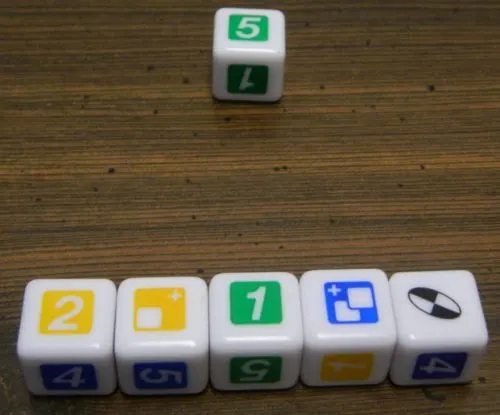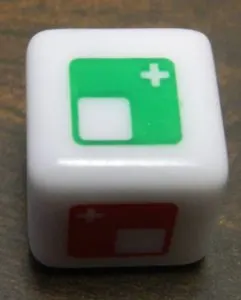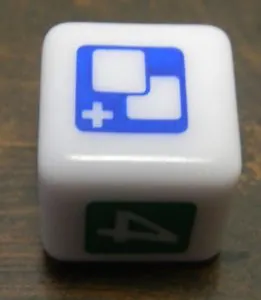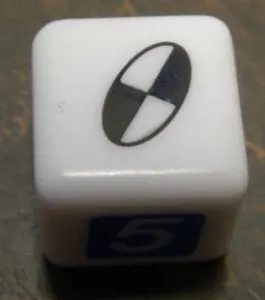With how popular UNO is it should surprise no one that eventually there would be an UNO dice game made at some point. What might be a little more surprising is that the idea was so obvious that there have actually been three different versions of UNO Dice created over the years. These aren’t just reprints of the same game either as the 1987, 1996, and 2011 versions of the game all play differently. Instead of looking at all three games in different reviews I decided to combine them all into one review in order to decide which version of the game is the definitive version of UNO Dice. Since I only own the 1996 and 2011 versions of the game, at this time the review will not cover the 1987 version. When I find a copy of the 1987 version of the game I will add my thoughts on that version as well. Despite being an obvious addition to the UNO line of games, UNO Dice does a surprisingly good job turning the original card game into a dice game.
How to Play UNO Dice
UNO Dice is a game that has had several versions over the years. While the games have a lot in common, I am going to include the rules for each version as there are some differences.
1996 UNO Dice
Setup
- Each player randomly draws five dice from the bag. The rest of the dice are left in the bag.
- All of the players roll their dice and leave them out on the table. Each players’ dice will be visible to the rest of the players for the entire game.
- One of the players randomly take a dice from the bag and roll it. If a number is not rolled, the die is rolled again. Once a number is rolled, this die will be the center die.
- The player who rolled the center die will start the round.
Playing the Game
A player begins the game by comparing their dice with the die in the center of the table. If the player has a die that matches the number, color or command on the center die they can play the die. When playing a die, the new die replaces the old center die. The old center die is returned to the bag.
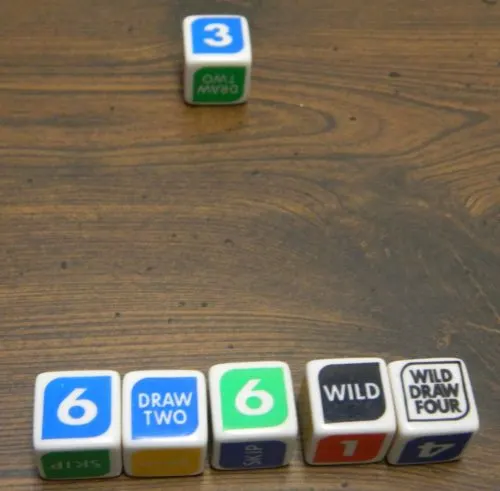
The current die is a blue three. This player can either play their blue six, blue draw two, or their wild dice.
If a player can’t play one of their dice or they choose not to, they roll all of their dice. If the player can now play a die, they have the opportunity to play it. If they still don’t have a die that they can play or choose not to, the player draws a die from the bag and rolls it. If they roll something that matches the number, color or command of the center die they can play it immediately.
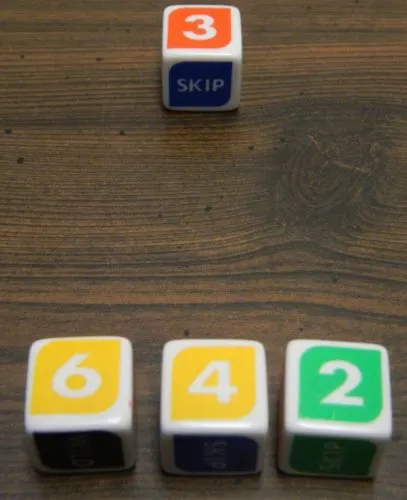
This player currently has no dice that they can play. They re-roll their dice. If they can play one of the dice, they can play it immediately. Otherwise they have to draw a die from the bag.
If at any time a player has to draw a die/dice and there are not enough left in the bag, the player draws as many dice as they can.
The next player then takes their turn trying to play a die that matches the center die.
When a player only has one die remaining they must announce “UNO.” If a player catches them not saying UNO before the next player takes their turn, the player who didn’t say UNO has to draw two dice from the bag and roll them.
Special Die
The game includes a couple special dice which give the player who plays them a special ability.
Reverse: When a reverse die is played, the direction of play reverses. For example if the play order is clockwise, after a reverse the play order will be counter clockwise.
Skip: The next player loses their turn.
Draw Two: The next player loses their turn and has to draw two dice from the bag. They will roll the two dice they take from the bag.
Wild: A wild die matches any other dice in the game. When a player plays a wild die they choose what color it will represent.
Wild Draw Four: When a player plays a wild draw four the next player has to draw four dice from the bag, roll the dice they drew, and lose their next turn. The player who played the die gets to choose the die’s color. A player can only play a wild draw four if they are unable to play a die that matches the color of the center die. If they play the die incorrectly, they have to draw the four dice.
Scoring
A round ends when one player has played their last die. If the last die played is a draw 2 or wild draw 4, the next player has to draw the corresponding number of dice and roll them. The player who played all of their dice scores points for the dice that the other players had remaining. Each die is worth the following:
- Number Dice: Face Value
- Draw 2, Reverse, Skip: 20 points
- Wild, Wild Draw Four: 50 points
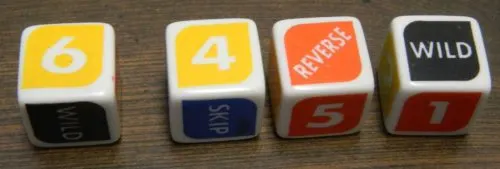
The player who won this round will score six points for the six, four points for the four, 20 points for the reverse, and 50 points for the wild.
If none of the players have 500 or more points, another round is played.
Winning the Game
The first player to score 500 or more points wins the game.
UNO Dice 2011
Setup
- Each player takes five dice.
- Both players roll one of their dice. The player who rolls the highest number starts the game (all special dice count as 0).
- Each player then rolls all five of their dice. This will be their starting hand. The dice are visible to the other player for the entire game.
- One of the players rolls the die that neither player took. If a number isn’t rolled, roll the die again until a number is rolled.
Playing the Game
On a player’s turn they will try to play a die from their hand that matches the number, color or symbol on the last played die. If a player has a matching die, they play it next to the last played die (either to the right or below depending on how the players chose to place the dice).
If a player doesn’t have a matching die or chooses not to play one of their dice, they take the die from the back (left or top die) and add it to their hand. The player will then roll all of their dice. If one of the dice now match the last played die, the player can play the die if they so choose.
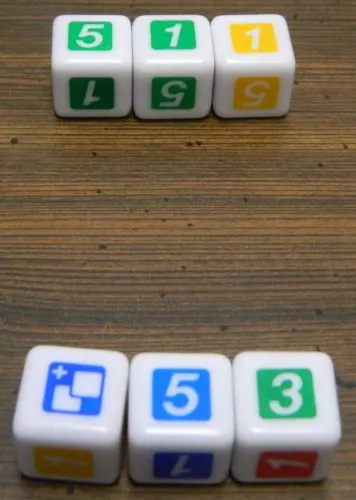
This player does not have a dice that they can play. They will take the green five die and then roll all of their dice. If they can then play one of their dice, they can play it immediately.
The next player then takes their turn (unless a special die was played).
When a player only has one die remaining, they must call out “UNO”. If the other player catches the player not saying UNO, the player with one die has to draw two dice from the back of the line and then roll all of their dice.
If a player is forced to draw a die/dice, one die always has to remain on the table. If a player has to draw more dice than are left on the table, they don’t draw all of the dice. If a player fails to call out “UNO” and there is only one die in the line, the player takes a die from the other player.
Special Dice
Draw One: The next player draws one die from the back of the line and has to roll all of their dice. The next player also loses their turn.
Draw Two: The same as draw one except that the next player draws two dice from the back of the line.
Wild: The wild die matches any other die. The player who plays the die gets to choose the current color.
Scoring
The round ends when one player plays their last die. If the last die played is a draw one or draw two, the other player has to take the corresponding die/dice from the line. The player who got rid of all of their dice will score points for the other player’s remaining dice as follows:
- Number Dice: Face Value
- Draw One, Draw Two: 20 points
- Wild: 50 points
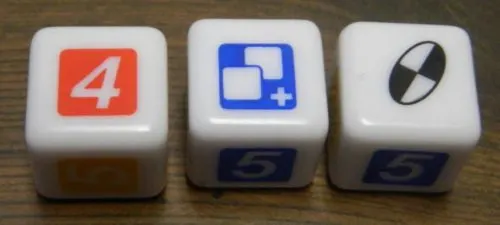
The player who won the round will score four points for the four, 20 points for the draw two and 50 points for the wild.
If neither player has 200 points, another round is played.
Winning the Game
The first player to score 200 or more points wins the game.
My Thoughts on UNO Dice
Before playing UNO Dice I will admit that I was a little skeptical as I didn’t think the original card game would translate that well to a dice game. I have to say that I was pleasantly surprised as the transition is actually pretty seamless. Basically the dice game feels like a streamlined version of the card game. The basic premise is the same as the objective is to get rid of all of your dice by playing a die that matches the color, number or symbol/action of the last played die. I have always liked the original UNO and while not drastically different UNO Dice has a lot of the same things that I enjoyed about the card game. If you like the UNO card game I think you will also like UNO Dice.
The streamlining in UNO Dice leads to the game playing quite a bit faster than the card game. The original card game was itself pretty quick but the dice game plays even quicker. Unless a player takes way too long to make a decision, I can’t see a round of UNO Dice taking more than like five minutes. The game plays so much quicker because there are less dice in the game which makes it easier to get rid of all of your dice. The game also lets you re-roll your dice which improves the odds of you being able to play one of your dice every turn. This would be like being able to swap your entire hand in UNO whenever you didn’t have a card that you could play. In a lot of situations you only have one choice so you can’t waste a lot of time debating which dice you want to play. Like the normal UNO though I would probably ditch the scoring rules as it will take many games for a player to score enough points to win. I think you are better off just playing as many rounds as you want and then determining the winner by who won the most rounds. With its short length I think UNO Dice works as well as a filler game as the original card game.
While the basic mechanics of UNO Dice are exactly the same as the original UNO, there is one small change that actually has a pretty big impact on the gameplay. In UNO Dice you have to play the game with all of your dice always in full view of the other players. This might not sound like much but it would be the same as playing the card game with your entire hand face up on the table. The reason that it has a pretty big impact on the game is that it allows you to always see what the other players can do on their turn. A player can look at what the next player has and then play a die that they can’t match. For quite a few of your turns being able to see what the other players have is not a huge deal but on some of your turns it can actually add a lot of strategy into your decision making.
The times where this mechanic matters most is when one of the players is down to their last die or two. Since everyone can see what the player needs in order to win the game, the players who play before them can take preventive actions to stop them from being able to play their last die. A player won’t play a die that allows a player to play their last die. Players have the option of not playing a die even if they are able to. If a player can’t prevent the next player from winning the game, they can refuse to play one of their current dice and hope to roll something that can prevent the next player from winning. While this mechanic doesn’t drastically change the game, it adds some strategy to the game which UNO is lacking at times.
So I mentioned earlier that this review is based on both the 1996 and 2011 versions of UNO Dice. In a lot of ways the two games share a lot in common but they are also different experiences. There are two main differences between the 1996 and 2011 version of UNO Dice. First the 2011 version has different special action dice than the 1996 version of the game. The wild draw four has been turned into a draw one and the skip and reverse have been removed entirely. It makes sense that the reverse and skip were removed since the 2011 version only supports two players. The fact that the 2011 version of the game only supports two players while the 1996 game supports up to four players is the other main difference between the two versions. While the different special abilities don’t have a big impact on the game, the fact that the 2011 version is only a two player game is the main reason that the 2011 version is considerably worse than the 1996 version of the game.
Outside of the fact that I think it is stupid limiting the game to only two players, it honestly leads to a lot of problems for the game. UNO Dice doesn’t work well with only two players. While I like the idea of being able to see what the other players have, it creates problems for the two player game. Since you know what the other player has, you are always going to play a die that forces the other player to draw a die if possible. This leads to a lot of back and forth as players force one another to draw dice. This makes the game drag on longer than it should. A player could be close to winning a round and then be forced to draw a lot of dice putting them right back where they started.
The other problem with only having two players is that players know what the other player needs in order to win the round. If a player can’t prevent the other player from winning with their current dice they will draw another dice and hope to roll something that will prevent the other player from winning the game. This makes it surprisingly difficult to win a round of UNO Dice. Basically you need to get lucky or have the right dice in front of you where you can set up a chain of dice preventing the other player from stopping you. This ultimately adds a lot of luck and randomness to who wins the game.
As far as components you basically get what you would expect out of a Mattel dice game. You get dice, instructions and a storage container. The dice quality of both versions of UNO Dice is pretty average. They serve their purpose but are far from special. I personally wish the dice were engraved instead of just painted on since I worry that the paint will fade off after a while. I also think the game could have done a better job making the yellow sides of the dice easier to read. In both versions of the game it is kind of hard to read what is on the yellow sides from a distance. As far as containers the 1996 version comes in a cloth bag while the 2011 version comes in what looks like a pop/soda can. I like that the 1996 version comes in a smaller container but the dice don’t stay in the bag as well as you would like. Meanwhile the 2011 version comes in the awkward can which is sturdy by kind of a pain to store.
Should You Buy UNO Dice?
While UNO Dice is not drastically different than the original UNO, it is an interesting take on the original game. All of the basics are the same as the original card game so fans of the card game will probably also enjoy UNO Dice. UNO Dice is more streamlined than the original UNO though which leads to the game playing quicker. Probably the biggest change in UNO Dice is the fact that players can see all of the other players’ dice at any time. This actually leads to a decent amount of strategy as you can play dice that will force the next player to draw dice and you can even put some strategy into preventing a player from winning the game. While these mechanics work pretty well in the three and four player game of the 1996 version of the game, the 2011 version only supports two players which creates a lot of problems for the game. Basically UNO Dice is what you would expect it to be, a dice game version of the original card game.
If you have never liked UNO, UNO Dice won’t change your name about the franchise. If you like UNO and dice games though, I think you could enjoy UNO Dice quite a bit. I would strongly suggest picking up the 1996 version of the game instead of the 2011 version though due to the issues with the 2011 version. I would only consider purchasing the 2011 version if you were only planning on playing the game two player and if you can find it considerably cheaper than the 1996 version.
If you would like to purchase UNO Dice you can find it online: Amazon (1987), Amazon (1996)
, Amazon (2011)
, eBay

